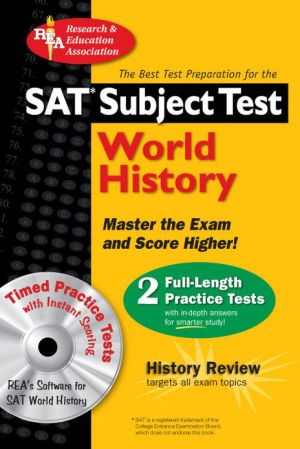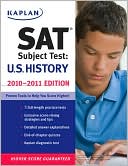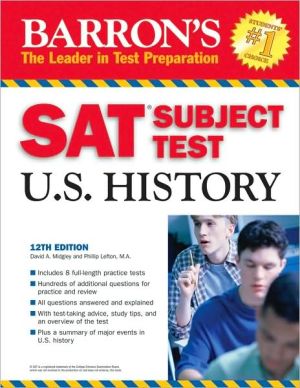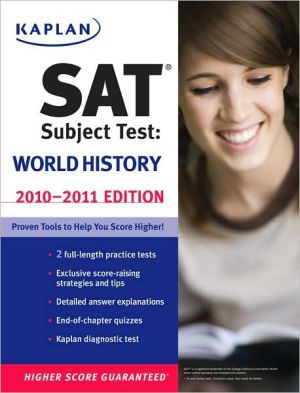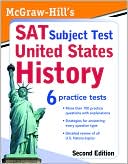SAT Subject Test World History
Taking the SAT* World History Subject Test?\ Then You Need REA's Test Prep for SAT* Subject Test: World History with Practice Tests on CD\ Our bestselling SAT* Subject Test: World History test prep includes a comprehensive review of the rise of civilizations around the world, the formation of nations, wars through the ages, and more. Each chapter contains examples and practice questions that help you study smarter and boost your test score.\ The book includes 2 full-length practice tests that...
Search in google:
REA's new SAT Subject Test for World History contains all the information students need to study smart and score high. The guide comes complete with an in-depth review of the rise of civilizations around the world, the formation of nations, and wars through the ages to events of today. Build your test-taking skills with full-length practice exams. Study smarter with detailed answers to every practice question. Each question is explained in an easy-to-understand format. Follow up your study with REA's test-taking strategies, drills and adaptable study schedule that get you ready for test day.
EXCELLING ON THE SAT WORLD HISTORY SUBJECT TEST \ ABOUT THIS BOOK AND TESTWARE®\ This book provides you with an accurate and complete representation of the SAT World History Subject Test. Inside you will find a complete course review designed to provide you with the information and strategies needed to do well on the exam, as well as two practice tests based on the actual exam. The practice tests contain every type of question that you can expect to appear on the SAT World History Subject Test. Following each test you will find an answer key with detailed explanations designed to help you master the test material.\ Practice Tests 1 and 2 are also included on the enclosed TESTware® CD. The software provides the benefits of instantaneous, accurate scoring and enforced time conditions.\ ABOUT THE TEST Who Takes the Test and What Is It Used for?\ Students planning to attend college take the SAT World History Subject Test for one of two reasons:\ (1) Because it's an admission requirement of the college or university to which they are applying,\ or\ (2) To demonstrate proficiency in world history.\ Many colleges use the SAT Subject Tests for admission or for course placement. Used in combination with other background information (your high school record, scores from other tests, teacher recommendations, etc.), these tests provide a dependable measure of academic achievement and help predict future performance.\ Who Administers the Test?\ The SAT World History Subject Test is developed by the College Board and administered by Educational Testing Service (ETS). The test development process involves the assistance of educators throughout the country, and is designed and implemented to ensure that the content and difficulty level of the test are appropriate.\ When Should the SAT World History be Taken?\ If you are applying to a college that requires Subject Test scores as part of the admissions process, you should take the SAT World History Subject Test toward the end of your junior year or at the beginning of your senior year. If your scores are being used only for placement purposes, you may be able to take the test later in your senior year. Make sure to contact the colleges to which you are applying for more specific information.\ If possible take the SAT World History test soon after completing your course of study in the subject, while the material is still fresh in your mind.\ When and Where is the Test Given?\ The SAT World History Subject Test is administered six times a year at many locations throughout the country, mostly high schools. The test is given in October, November, December, January, May, and June.\ To receive information on upcoming administrations of the exam, consult the publication Taking the SAT Subject Tests, which may be obtained from your guidance counselor or by contacting:\ College Board SAT Program P.O. Box 6200\ Princeton, NJ 08541-6200\ Phone: (609) 771-7600\ Website: www.collegeboard.com\ Is there a Registration Fee?\ You must pay a registration fee to take the SAT World History test. Consult the publication Taking the SAT Subject Tests for information on the fee structure. Financial assistance may be granted in certain situations. To find out if you qualify and to register for assistance, contact your academic advisor.\ HOW TO USE THIS BOOK AND TESTware®\ What Do I Study First?\ Remember that the SAT World History Subject Test is designed to test knowledge that has been acquired throughout your education. Therefore, the best way to prepare for the exam is to refresh yourself by thoroughly studying our review material and taking the sample tests provided in this book. They will familiarize you with the types of questions, directions, and format of the SAT World History Subject Test.\ To begin your studies, read over the reviews and the suggestions for test-taking, take Practice Test 1 on CD-ROM to determine your area(s) of weakness, and then restudy the review material, focusing on your specific problem areas. The course review includes the information you need to know when taking the exam. Make sure to follow up your diagnostic work by taking Practice Test 2 on CD-ROM to become familiar with the format of the SAT World History Subject Test.\ When Should I Start Studying?\ It is never too early to start studying for the SAT World History test. The earlier you begin, the more time you will have to sharpen your skills. Do not procrastinate! Cramming is not an effective way to study, since it does not allow you the time needed to learn the test material. The sooner you learn the format of the exam, the more comfortable you will be when you take it.\ CONTENT AND FORMAT OF THE SAT WORLD HISTORY TEST The World History is a one-hour exam consisting of 95 multiple-choice questions. Each question has five possible answer choices, lettered (A) through (E). Topics cover the entire history of the world, from ancient times to the present, including all inhabitable continents.\ The following tables summarize the distribution of topics covered on the SAT World History exam:\ Chronological Material Covered Approx. Percentage of Questions on the test Pre-History and Civilizations to 500 C.E. 25\ 500 to 1500 C.E. 20\ 1500 - 1900 C.E. 25\ Post - 1900 C.E. 20\ Cross-chronological 10\ Geographical Material Covered Approx. Percentage of Questions on the test Europe 25\ Africa 10\ Southwest Asia 10\ South and Southeast Asia 10\ East Asia 10\ The Americas (excluding the U.S.) 10\ Global or Comparative 25\ Scoring the SAT World History The SAT World History Test, like all other Subject Tests, is scored on a 200-800 scale.\ How Do I Score My Practice Test?\ Your exam is scored by crediting one point for each correct answer and deducting one-fourth of a point for each incorrect answer. There is no deduction for answers that are omitted. Use the worksheet below to calculate your raw score and to record your scores for the two practice tests in this book.\ Scoring Worksheet\ _____________ - (___________ ´ 1/4) = ____________\ number correct number incorrect Raw Score\ (do not include (round to nearest unanswered questions) whole point)\ Raw Score Scaled Score Test 1 ____________ ____________\ Test 2 ____________ ____________\ Calculating Your Scaled Score Scores on the SAT World History Subject Test range from 200 to 800. This table shows you how to convert your raw score to a scaled score.*\ SCORE CONVERSION TABLE Raw Score Scaled Score Raw Score Scaled Score\ 50 800 18 490\ 49 790 17 480\ 48 780 16 470\ 47 780 15 460\ 46 770 14 460\ 45 750 13 450\ 44 740 12 440\ 43 740 11 430\ 42 730 10 420\ 41 720 9 420\ 40 710 8 410\ 39 710 7 400\ 38 700 6 390\ 37 690 5 380\ 36 680 4 380\ 35 670 3 370\ 34 660 2 360\ 33 650 1 350\ 32 640 0 340\ 31 630 -1 340\ 30 620 -2 330\ 29 600 -3 320\ 28 590 -4 310\ 27 580 -5 300\ 26 570 -6 300\ 25 560 -7 280\ 24 550 -8 270\ 23 540 -9 260\ 22 530 -10 260\ 21 520 -11 250\ 20 510 -12 240\ 19 500\ STUDYING FOR THE TEST It is very important to choose the time and place for studying that works best for you. Some students may set aside a certain number of hours every morning to study, while others may choose to study at night before going to sleep. Other students may study during the day, while waiting on a line, or even while eating lunch. Only you can determine when and where your study time will be most effective. Be consistent and use your time wisely. Work out a study routine and stick to it!\ When you take the practice tests, try to make your testing conditions as much like the actual test as possible. Turn your television and radio off, and sit down at a quiet table free from distraction. Make sure to time yourself with a timer.\ As you complete each practice test, score your test and thoroughly review the explanations to the questions you answered incorrectly; however, do not review too much at any one time. Concentrate on one problem area at a time by reviewing the questions and explanations, and by studying our review until you are confident you completely understand the material.\ Keep track of your scores. By doing so, you will be able to gauge your progress and discover general weaknesses in particular sections. You should carefully study the reviews that cover your areas of difficulty, as this will build your skills in those areas.\ TEST-TAKING TIPS Although you may be unfamiliar with standardized tests such as the SAT World History Subject Test, there are many ways to acquaint yourself with this type of examination and help alleviate your test-taking anxieties. Listed below are ways to help you become accustomed to the SAT World History test, some of which may apply to other standardized tests as well.\ Become comfortable with the format of the exam. When you are practicing to take the SAT World History Subject Test, simulate the conditions under which you will be taking the actual test. Stay calm and pace yourself. After simulating the test only a couple of times, you will boost your chances of doing well, and you will be able to sit down for the actual exam with much more confidence.\ Know the directions for the test. Familiarizing yourself with the directions and format of the exam will not only save you time, but will also ensure that you are familiar enough with the test to avoid nervousness (and the mistakes caused by being nervous).\ Do your scratchwork in the margins of the test booklet. You will not be given scrap paper during the exam, and you may not perform scratchwork on your answer sheet. Space is provided in your test booklet to do any necessary work or draw diagrams.\ If you are unsure of an answer, guess. However, if you do guess, guess wisely. Use the process of elimination by going through each answer to a question and ruling out as many of the answer choices as possible. By eliminating three answer choices, you give yourself a fifty-fifty chance of answering correctly since there will only be two choices left from which to make your guess.\ Mark your answers in the appropriate spaces on the answer sheet. Each numbered row will contain five ovals corresponding to each answer choice for that question. Fill in the circle that corresponds to your answer darkly, completely, and neatly. You can change your answer, but remember to completely erase your old answer. Any stray lines or unnecessary marks may cause the machine to score your answer incorrectly. When you have finished working on a section, you may want to go back and check to make sure your answers correspond to the correct questions. Marking one answer in the wrong space will throw off the rest of your test, whether it is graded by machine or by hand.\ You don't have to answer every question. You are not penalized if you do not answer every question. The only penalty you receive is if you answer a question incorrectly. Try to use the guessing strategy, but if you are truly stumped by a question, you do not have to answer it.\ Work quickly and steadily. You have a limited amount of time to work on each section, so you need to work quickly and steadily. Avoid focusing on one problem for too long. Taking the practice tests in this book will help you to learn how to budget your time.\ Before the Test Make sure you know where your test center is well in advance of your test day so you do not get lost on the day of the test. On the night before the test, gather together the materials you will need the next day:\ o Your admission ticket o Two forms of identification (e.g., driver's license, student identification card, or current alien registration card)\ o Two No. 2 pencils with erasers o Directions to the test center o A watch (if you wish) but not one that makes noise, as it may disturb other test-takers On the day of the test, you should wake up early (it is hoped after a decent night's rest) and have a good breakfast. Dress comfortably, so that you are not distracted by being too hot or too cold while taking the test. Also, plan to arrive at the test center early. This will allow you to collect your thoughts and relax before the test, and will also spare you the stress of being late. If you arrive after the test begins, you will not be admitted and you will not receive a refund.\ During the Test When you arrive at the test center, try to find a seat where you feel you will be comfortable. Follow all the rules and instructions given by the test supervisor. If you do not, you risk being dismissed from the test and having your scores canceled.\ Once all the test materials are passed out, the test instructor will give you directions for filling out your answer sheet. Fill this sheet out carefully since this information will appear on your score report.\ After the Test When you have completed the SAT World History Subject Test, you may hand in your test materials and leave. Then, go home and relax!\ When Will I Receive My Score Report and What Will It Look Like?\ You should receive your score report about five weeks after you take the test. This report will include your scores, percentile ranks, and interpretive information.
CONTENTS\ Excelling on the SAT World History Subject Test About This Book and TESTware®\ About the Test How to Use This Book and TESTware®\ Content and Format of the SAT World History Test \ Studying for the Test Test-Taking Tips \ Chapter 1\ The Prehistoric Era The Paleolithic Era The Neolithic Era and the Development of Agriculture \ Chapter 2\ The First Civilization: Mesopotamia \ Geography of Ancient Mesopotamia and Cultural Pessimism The Rise of Empires in Mesopotamia\ Chapter 3\ The Hittites\ Chapter 4\ Egypt: The Gift of the Nile Geography of Ancient Egypt\ Chapter 5\ The Hebrews Hebrew Origins\ Chapter 6\ Indian Civilization Through the Mauryan Empire Overview\ Chapter 7\ China Through the Han Geography, Agriculture, the Family, and the Peasant in Ancient China The Prehistoric Era The Hundred Schools of Chinese Philosophy\ Chapter 8\ Ancient Greece The Minoans The Mycenaeans The Trojan War The Dorians Archaic Culture: The Olympics Greek Culture During the Golden Age of Greece\ Chapter 9\ The Golden Age of Greece The Greek City-States The Persian Wars The Age of Pericles The Peloponnesian War The Defeat of Athens\ Chapter 10\ Alexander the Great and the Hellenistic Era The Aftermath of the Peloponnesian War The Hellenistic Empire Hellenistic Art\ Chapter 11\ The Civilization of Rome The Etruscans Rome Becomes Master of the Mediterranean The Age of the Reformers The First Emperor of Rome: Augustus Religion in the Roman Empire The Emperor Constantine: First Christian Emperor of Rome The Decline and Fall of the Roman Empire in the West\ Chapter 12\ The Rise of Islam The Life and Career of Muhammad The Teachings of Islam\ Chapter 13\ Africa on the Eve of the Age of Exploration Geography of Africa Ancient Africa After the Egyptians Islam in Africa Other Cultures of Africa\ Chapter 14\ The Americas Before Columbus The Native American Cultures of Mesoamerica Native American Cultures of South America: The Inca Native American Cultures of North America The Southwestern Native Americans: The Anasazi\ Chapter 15\ Asia from 500 C.E. to 1400 C.E.\ China Japan Angkor Majapahit Empire of Mahmud Ghazni\ Chapter 16\ The Western Middle Ages The Historiography of the Medieval Period The Byzantine Empire During the Early Middle Ages The Development of the Medieval European Kingdoms Emergence of the Medieval Monarchies:\ France and England in the Central Middle Ages \ Germany in the Central Middle Ages The Central Middle Ages\ Chapter 17\ The Late Middle Ages The Decline of the Church in the Late Middle Ages The Hundred Years' War\ Chapter 18\ The Renaissance 1\ Chapter 19\ The Age of Exploration The Voyages of Exploration Other Voyages to the Americas Reasons for the Success of the Spanish Conquest\ Chapter 20\ The Reformation Martin Luther The Aftermath of Luther's Career The English Reformation The Counter Reformation\ Chapter 21\ The Scientific Revolution and the Enlightenment Nicholas Copernicus Johann Kepler Galileo Isaac Newton Blaise Pascal Francis Bacon Rene Descartes Baruch Spinoza Critique of the Bible John Locke The Enlightenment Francois Marie Arouet Thomas Paine Denis Diderot Edward Gibbon Marie Jean Antoine Nicolas De Caritat Condorcet Other Enlightened Thinkers\ Chapter 22\ Classicism\ Chapter 23\ Louis XIV Thomas Hobbes Colbert and Economic Reform The Centralized Bureaucracy Control of the Three Estates Nec Pluribus Impar: None His Equal\ Chapter 24\ The Rise of Prussia and the House of Hohenzollern Frederick William, The Great Elector Frederick William I Frederick II (The Great)\ Chapter 25\ The Austrian Hapsburgs and the Holy Roman Empire Charles V The Three Crowns of the Holy Roman Empire\ Chapter 26\ Peter the Great and the Westernization of Russia The Geographical Location of Russia The Russian Monarchy The Modernization of Russia\ Chapter 27\ The Stuart Monarchy and the Glorious Revolution in England The Puritans The Catholicism of the Stuarts Absolutist Policies of the Stuarts The Long Parliament The English Civil War Oliver Cromwell The Restoration\ Chapter 28\ Japan from the Warring States Through the Meiji Restoration The Warring States Tokugawa Japan Japan and the West\ Chapter 29\ China from the Ming to the Ching Dynasty The Ming Dynasty Expansion Under Later Emperors: The Maritime Expeditions of the Yung-Lo Emperor Artistic and Cultural Accomplishments of the Ming The Decline of the Ming The Ching (Qing) Dynasty\ Chapter 30\ The Islamic World from the Ottomans through the Early Twentieth Century The Ottoman Empire\ Chapter 31\ The British Colonies in the Americas and the American Revolution The European Colonies in the Americas French Explorations and Colonization of the Americas Dutch Colonization English Colonization of the New World Mercantilism British Colonial Rule Virginia Resolutions The Declaration of Independence\ Chapter 32\ The French Revolution The Revolt Noblesse\ Chapter 33\ The American and French Revolutions Spark Other Movements for Independence The Haitian Revolution\ Chapter 34\ The Industrial Revolution The Steam Engine\ Chapter 35\ The Revolutions of 1848\ Terms Revolt in Paris and the Abdication of Louis Philippe The Italian States The Aftermath of the Revolutions\ Chapter 36\ The Unification of Italy and Germany Italy Germany\ Chapter 37\ Romanticism\ Chapter 38\ America in the Nineteenth Century\ Chapter 39\ European and U.S. Imperialism in the Nineteenth Century J.A. Hobson Joseph Arthur De Gobineau and Herbert Spencer New Developments in Technology European Explorations of Africa The Berlin West Africa Conference European Imperialism in the Pacific The United States Emerges as an Imperial Power The Rise of Japan as an Imperial Power Imperialism and the Labor Force\ Chapter 40\ Russia in the Early Twentieth Century The Revolution of 1905\ The Revolutions of 1917\ The Soviet Union from 1920 to 1927\ Chapter 41\ World War I and Its Aftermath Nationalism Imperialism Early Twentieth-Century Conflicts Alliance Building Major Treaties that Created the System of Alliances Global Depression in the Wake of World War I }\ Asia After World War I China After World War I Japan in the Post-War Era\ Chapter 42\ The Rise of Fascism The Rise of Hitler The Rise of Mussolini\ Chapter 43\ World War II Hitler Invades Poland The Germans Begin the Two-Front War The War in the Pacific and the U.S. Declaration of War The Atomic Bomb Aftermath\ Chapter 44\ The Cold War Yalta The Cold War The Truman Doctrine NATO and the Warsaw Pacts The Korean War Castro in Cuba The Vietnam War Challenges to the Superpowers\ Chapter 45\ Developments in the Post-World War II Era China After World War II India After World War II The Middle East After World War II The Creation of Israel and the Problem of Palestine Egypt Terrorism on the Rise in 1983 and 1984\ Latin America in the Post-World War II Era Africa After World War II A New World Order\ Chapter 46\ Emerging Global Trends The Population Explosion Poverty Terrorism Ethnic Conflicts Impact of Globalism\ Practice Test 1\ Answer Sheet Answer Key Detailed Explanations of Answers\ Practice Test 2\ Answer Sheet Answer Key Detailed Explanations of Answers\ Installing REA's TESTware®\ Index
